An excellent alternative in the absence of a main gas pipeline: heating from a gas cylinder

Liquefied bottled gas, which is propane-butane mixture, is one of the most profitable ways of heating private houses, garages and apartments in the price/quality category.
Content
Features of heating from gas cylinders
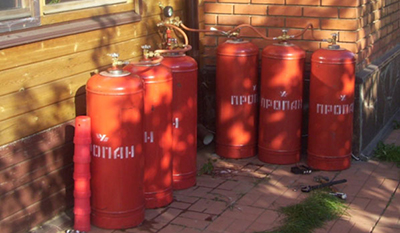
The following are used as a heat source: butane or propane. Once the gas is liquefied, it is distilled into cylinders. These are then connected to the heating system via gearbox - a device that reduces pressure.
As it passes through it, the gas returns to its natural state. It is then burned in the boiler, releasing a large amount of heat.
Reasons for choosing
- Low cost;
- low fuel consumption gives off a lot of heat;
- connection of such a heating system is permissible at any time and after using other types of boilers;
- use of this type of fuel acceptable in any terrain and building.
Gas or electricity
This is a question that everyone who is considering various analogues heating sources. To make a decision, it is important to compare them by key indicators.
Gas
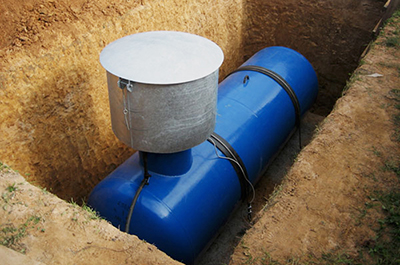
By cost 1.5–2 times cheaper than electricity. The financial side of the issue will be especially noticeable if the building is large.
Autonomous heating works by means of gas tank, located underground. It can hold thousands of liters of gas. The gas holder is filled by specialists twice a year.
The underground reservoir does not interfere with the full use of the territory and does not emit an attention-grabbing odor.
Electricity
The costs are high because this energy source is considered one of the most expensive.
Sometimes the power consumed by the heating system is too high for a country power grid, and there is not enough energy to heat the entire house.
In bad weather, it often happens power surges, which leads to a failure in the heating system.
It follows from this that liquefied gas is a more profitable, economical and reliable option.
Storage of liquefied fuel
The gas is contained in gas holders or special containers that have spherical or cylindrical shape ground or underground type of installation.
Such tanks must be welded.
Cylinders for storing liquefied gas are produced from sheet steelThey consist of a neck, two bottoms, a shut-off valve, a plug, a cap, a shoe, and a shell.
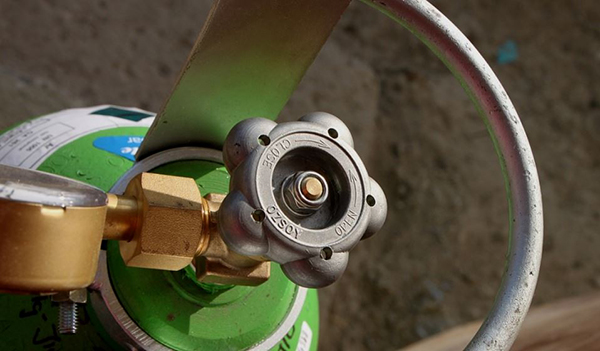
Photo 1. Gas cylinder for storing liquefied fuel with a neck, shut-off valve, and plug.
Each cylinder is marked with its type, weight and capacity, permissible pressure, Quality control stamp of the company and Gosgortekhnadzor, test pressure obtained during hydraulic testing, date of completed and subsequent inspections, name of the manufacturer.
The balloon has red paint and white signature "propane - butane".
Reference! Before shipping, the cylinders are stored in specialized facilities. one-story warehouses in the form of premises or open areas under a canopy.
Advantages and disadvantages of balloon heating
Pros:
- constant pressure level in pipes;
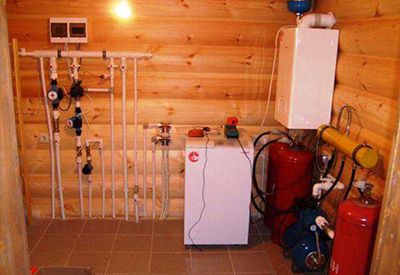
- minimal fuel consumption;
- autonomy works;
- ease of use and management;
- clean natural fuel;
- the possibility of heating water for private needs.
Cons:
- freezing of condensate at low temperatures;
- the placement of cylinders is strictly provided for in ventilated areas;
- in case of a leak, the gas goes down into the basement or crawl space, leading to serious consequences.
Fuel consumption: how long does it last?
For heating a building with a total area 100 sq. m. per week on average it takes 2-3 cylinders, each with a capacity 50 lBased on these calculations, you can determine the required number of gas tanks for a house of any square footage and how long it lasts.
DIY heating boiler device
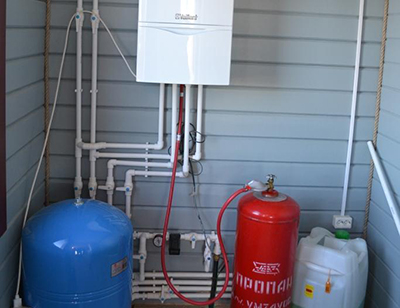
To create a heating system of this type with your own hands, you will need:
- Gas boiler with burner for liquefied gas. Models with low pressure and the highest efficiency rating are suitable.
- Gas cylinders with a capacity of 50 liters.
- Shut-off valves.
- Gearboxes.
- Ramp (used to connect several containers).
- Gas pipeline, formed from hoses and pipes and designed to connect elements to the heating system.
There are boilers floor and wall, single- and double-circuit. The latter allow not only to increase the temperature in the room, but also to heat the water.
The cylinders are connected to the system using a reducer with a capacity of 2 cubic meters/hour. The reducer can be one or separate for each tank.
Connecting several cylinders to a gas boiler increases the time it takes to refill them. For such a connection, use ramp - a device that divides tanks into main and reserve ones. First, gas is taken from the first group, and as it runs out, from the second. The moment of transition is announced by a signal.
To fix a gas boiler with a gas pipeline, use flexible eyeliner, and for the reducer - a durite hose. The wall thickness of the metal gas pipe is not less than 0.2 cmIn the wall, such pipes are placed in a casing and filled with foam.
The fuel consumption of the boiler is about 9 kg of gas per day. A large amount of resources will be spent at the very beginning to warm up the heating system, and later - will decrease by 4 times.
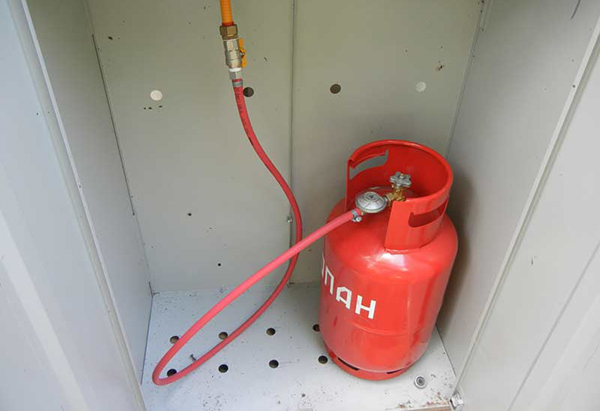
Photo 2. Red gas cylinder and flexible hose used for connection to the boiler.
Refueling cylinders are produced weekly specialists. Before this process, condensate is removed from the tanks. You can independently take the tanks to an open space, ground them and remove the reducer. After 2 hours, when the remaining gas has evaporated and the water has flowed into the ground, the cylinders can be taken to the filling station.
Important! Simultaneous refueling is not permitted. more than three cylinders.
Features of use
There are in different rooms your own rules operation of gas cylinders.
In the apartment
Installation of a gas boiler is permitted only if the following conditions are met:
- obtaining a number of approvals for this process from specialized services;
- purchase of necessary equipment;
- preparing the apartment;
- change of heating system - its disconnection from centralized communications;
- installation of chimney and ventilation.
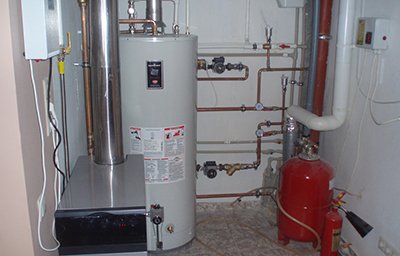
At the same time, the premises themselves must meet the following requirements:
- area not less than 4 sq. m;
- availability of good natural light, windows;
- ceiling height not less than 2.5 m;
- entrance door with a width of at least 0.8 m;
- cold water pipeline;
- even walls.
Gas cylinders are allowed to be placed in the apartment, but no more than one. At the same time, the building itself should not exceed 2 floors. Such containers are fixed 50 cm from the gas stove And 100 cm from heating devices. The maximum temperature of the room in which the installation process is carried out is not higher than 45 °C.
Attention! Carry out the process of installing a gas heating system yourself strictly prohibited, This is done by special services employees.
In a private house
Along with the installation of a gas heating system, heating is carried out in individual rooms. fixing convectors — devices that allow you to warm up a room in a few minutes.
It is used as a storage facility for cylinders. gas holderIts volume is determined during calculations. LPG consumption level. It is important to take into account the fireplace, the hot water boiler, and the gas stove. The higher this indicator, the larger the volume of the selected container.
In the garage
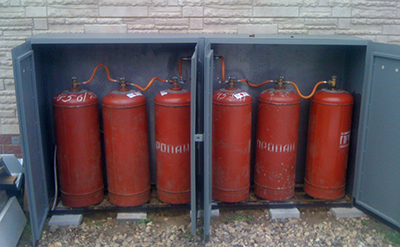
This structure is considered fire hazardous, so the gas boiler must be moved out a separate room with an area of at least 4 sq. m. with walls made of non-combustible materials.
Gas cylinders are located in a special metal cabinet, at a safe distance from flammable objects, above the floor level. This will allow you to quickly notice and prevent a gas leak.
Useful video
From the video you can learn how to connect the boiler to a gas cylinder and make the device autonomous.
Security measures
A general set of rules that must be followed in order to avoid unpleasant consequences:
- unprofessional and independent intervention is unacceptable in the formation of the gas heating process;
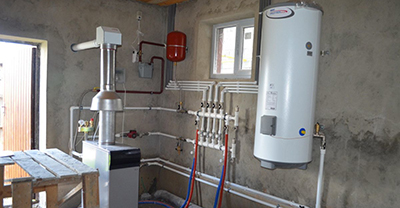
- in rooms with gas appliances installation of alarm devices is desirable, notifying about system problems;
- exhaust ventilation is installed only with natural draft;
- room with gas appliances equip with triple air exchange;
- in the absence of central heating Do not use a gas stove as a heat source.








